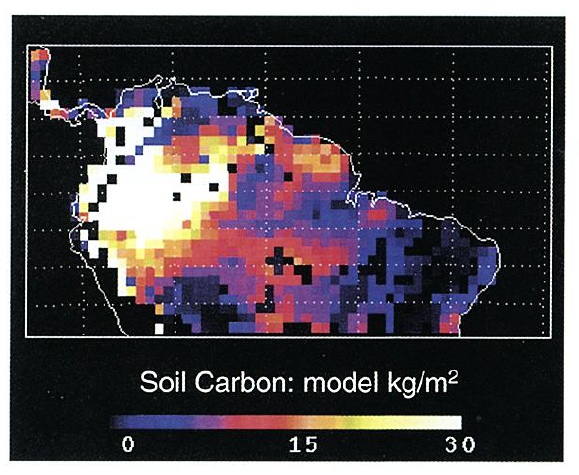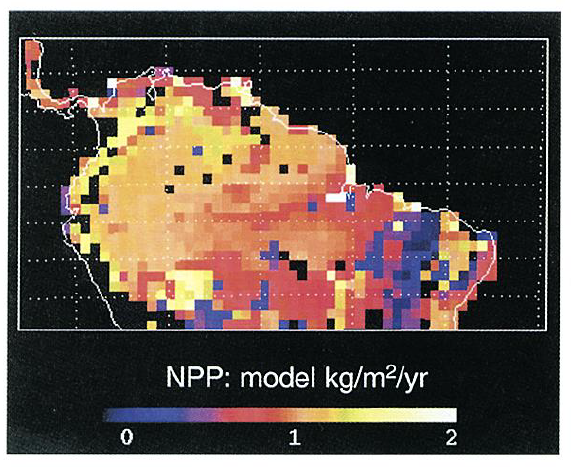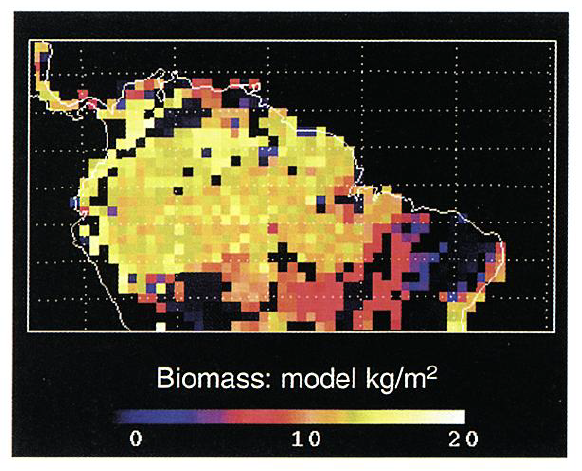Summary:
This data set provides Ecosystem Demography Model (ED)
estimates of potential above-ground net primary production (NPP) (kg C/m2/y),
potential average live biomass (kg C/m2), and potential average soil carbon (kg C/m2) for the Brazilian Amazon at 1.0 degree resolution.
Ecosystem Demography Model predicts both ecosystem structure (e.g. above and below-ground biomass, vegetation height and basal area,
and soil carbon stocks) and corresponding ecosystem fluxes (e.g. NPP, NEP, and evapotranspiration) from climate, soil, and land-use inputs.
Estimates for the Brazilian Amazon include the effects of natural disturbances such as windthrow and fire, but do not include the effects of human land use.
To produce these estimates, ED was forced with ISLSCP I data for 1987 and 1988
and averaged into a single average year (Moorcroft et al., 2001).
The data are provided for the three estimates in both ASCII text and in NetCDF formatted files.



Figure 1. Model predictions for the Brazilian Amazon at 1.0 degree resolution of soil carbon stocks (kg C/m2), average annual above-ground NPP (kg C/m2/y), and average above and below-ground live biomass, (kg C/m2) ( Moorcroft et al., 2001).
Data Citation:
Cite this data set as follows:
Moorcroft P.R., G.C. Hurtt, and S.W. Pacala. 2012. LBA-ECO LC-08 Ecosystem Demography Model Estimated C, NPP, and Biomass for Amazonia. Data set. Available on-line [http://daac.ornl.gov] from Oak Ridge National Laboratory Distributed Active Archive Center, Oak Ridge, Tennessee, U.S.A. http://dx.doi.org/10.3334/ORNLDAAC/1102
Implementation of the LBA Data and Publication Policy by Data Users:
The LBA Data and Publication Policy [http://daac.ornl.gov/LBA/lba_data_policy.html] is in effect for a period of five (5) years from the date of archiving and should be followed by data users who have obtained LBA data sets from the ORNL DAAC. Users who download LBA data in the five years after data have been archived must contact the investigators who collected the data, per provisions 6 and 7 in the Policy.
This data set was archived in June of 2012. Users who download the data between June 2012 and May 2017 must comply with the LBA Data and Publication Policy.
Data users should use the Investigator contact information in this document to communicate with the data provider. Alternatively, the LBA website [http://lba.inpa.gov.br/lba/] in Brazil will have current contact information.
Data users should use the Data Set Citation and other applicable references provided in this document to acknowledge use of the data.
Table of Contents:
- 1 Data Set Overview
- 2 Data Characteristics
- 3 Applications and Derivation
- 4 Quality Assessment
- 5 Acquisition Materials and Methods
- 6 Data Access
- 7 References
1. Data Set Overview:
Project: LBA-ECO
Activity: Modeling the Biogeochemical System of the Terrestrial Amazon
LBA Science Component: Land Use and Land Cover
Team ID: LC-08 (Moore / Nobre)
The investigators were Braswell, Rob H.; Frolking, Steve; Hagen, Stephen Charles; Hurtt, George C.; Moorcroft, Paul R.; Moore, Berrien; Nobre, Carlos Afonso; Pacala, Steve; Peterson, Bruce J.; Tian, Hanqin; Vorosmarty, Charles J.; Wildes, Pam and Xiao, Xiangming . You may contact Dr. George C.Hurtt (george.hurtt@unh.edu).
LBA Data Set Inventory ID: LC08_Ecosystem_Demography_Model
This data set provides Ecosystem Demography Model (ED)
estimates of potential above-ground net primary production (NPP) (kg C/m2/y),
potential average live biomass (kg C/m2), and potential average soil carbon (kg C/m2) for the Brazilian Amazon at 1.0 degree resolution.
Ecosystem Demography Model predicts both ecosystem structure (e.g. above and below-ground biomass, vegetation height and basal area,
and soil carbon stocks) and corresponding ecosystem fluxes (e.g. NPP, NEP and evapotranspiration) from climate, soil, and land-use inputs.
Estimates for the Brazilian Amazon include the effects of natural disturbances such as windthrow and fire, but do not include the effects of human land use.
To produce these estimates, ED was forced with ISLSCP I data for 1987 and 1988
and averaged into a single average year (Moorcroft et al., 2001).
2. Data Characteristics:
There are three ASCII text data files and three NetCDF format files with this data set with a grid cell size of 1.0 degree by 1.0 degree. This data set covers southern Latin America and the northern half of South America from 15 degrees N to 15
degrees S latitude and spans from 30 degrees W to 85 degrees W longitude.
The descriptions for three estimates in the ASCII (*.txt) and the netCDF (*.nc) formated files are the same. The *.nc file is the gridded version of the text file.
Data File Descriptions:
a) ED_SA_v1_Soil.txt and ED_SA_v1_Soil.nc:
Estimates of potential average soil carbon (kg C m-2), including litter and necromass, at 1.0 degree resolution. These estimates include
the effects of natural disturbances such as windthrow and fire, but do not include the effects of human land use.
b) ED_SA_v1_Biomass.txt and ED_SA_v1_Biomass.nc: Estimates of potential average live biomass (kg C m-2) at 1.0 degree resolution. These estimates include the effects of natural disturbances
such as windthrow and fire, but do not include the effects of human land use.
c) ED_SA_v1_NPP.txt and ED_SA_v1_NPP.nc: Estimates of the potential net primary production per grid cell (kg C m-2 yr-1), on a monthly basis. These estimates include the effects of natural disturbances such
as windthrow and fire, but do not include the effects of human land use.
Data Format:
The full data set contains 30 rows by 55 columns of floating point data.
The fill value for missing data and sea mask is -9.9.
Data Set Variables Data Range
ED: Amazonia
1) Potential Soil Carbon (kg C m-2) 0.000043 to 29.88
2) Potential Live Biomass (kg C m-2) 0 to 18.61
3) Potential NPP (kg C m-2 yr-1) (monthly) -0.57 to 4.54.
Example Data record from ED_SA_v1_Soil.txt
|
Band Name: biomass Description: 1 degree grid cell size. Ecosystem Demography Model (ED) for Amazonia: Estimate of potential live above and below ground biomass. See data references and details in the Auxiliary file or the Data Guide. Holding name: Potential Live Biomass Collection name: Ecosystem Demography Model Data Date class: snapshot Begin date of output End date of output Time step units: snapshot Data units: kg C m-2 Fill value: -9.9 Center Lon,Center Lat,snapshot -84.500000,14.500000,13.210 -83.500000,14.500000,12.413 -82.500000,14.500000,-9.900 -81.500000,14.500000,-9.900 ... -40.500000,-14.500000,15.518 -39.500000,-14.500000,14.750 -38.500000,-14.500000,-9.900 -37.500000,-14.500000,-9.900 -36.500000,-14.500000,-9.900 -35.500000,-14.500000,-9.900 -34.500000,-14.500000,-9.900 -33.500000,-14.500000,-9.900 -32.500000,-14.500000,-9.900 -31.500000,-14.500000,-9.900 -30.500000,-14.500000,-9.900 |
Site boundaries: (All latitude and longitude given in decimal degrees)
| Site (Region) | Westernmost Longitude | Easternmost Longitude | Northernmost Latitude | Southernmost Latitude | Geodetic Datum |
|---|---|---|---|---|---|
| South America including Amazonia (South America including Amazonia) | -85 | -30 | 15 | -15 | World Geodetic System, 1984 (WGS-84) |
Time period
- The data set covers the period 1987/01/01 to 1988/12/31
- Temporal Resolution:
Platform/Sensor/Parameters measured include:
- COMPUTER MODEL / MODEL ANALYSIS / PRIMARY PRODUCTION
- COMPUTER MODEL / MODEL ANALYSIS / BIOMASS
- COMPUTER MODEL / MODEL ANALYSIS / ECOSYSTEM FUNCTIONS
- COMPUTER MODEL / MODEL ANALYSIS / CARBON
3. Data Application and Derivation:
ED is being used to examine how climate and edaphic factors, natural disturbances, and human land-use practices affect ecosystem structure and fluxes. Coupled versions are in development to consider potential feedbacks to the atmosphere.
4. Quality Assessment:
Not available.
5. Data Acquisition Materials and Methods:
Model Description:
The Ecosystem Demography Model (ED), an individual-based terrestrial ecosystem model, predicts both ecosystem structure (e.g. above and below-ground biomass, vegetation height and basal area, and soil carbon stocks) and corresponding ecosystem fluxes (e.g. NPP, NEP, and evapotranspiration) from climate, soil, and land-use inputs. The model consists of integrated sub-models governing processes such as leaf-level physiology, plant allocation, allometry, phenology, dispersal, the effects of fire disturbances, and below-ground sub-models for soil carbon dynamics and hydrology. Using a new method for scaling-up it is possible to predict ED's large-scale behavior without simulating the fate of every plant individually.
The model was applied to the Brazilian Amazon for estimates of potential above-ground net primary production (kgC/m2/y) at 1.0 degree resolution, potential average live biomass (kgC/m2) at 1 degree resolution, and potential average soil carbon (kgC/m2) at 1 degree resolution. These estimates include the effects of natural disturbances such as windthrow and fire, but do not include the effects of human land use.
Model Inputs:
The model was run using data from the International Satellite Land Surface Climatology Project (ISLSCP) Initiative I CD (Meeson et al., 1995). The data sets from the ISLSCP CD are organized into five groups: Vegetation; Hydrology and Soils; Snow, Ice, and Oceans; Radiation and Clouds; and Near-Surface Meteorology. The data for 1987 and 1988 were averaged into a single average year. The ISLSCP I data sets provide modelers with many of the fields required to prescribe boundary conditions and to initialize and force a wide range of land-biosphere-atmosphere models. All of the data have been processed using the same land/sea mask and steps have been taken to ensure spatial and temporal continuity of the data. The data cover the period 1987-1988 at 1-month time resolution for most of the seasonally varying quantities and at 6-hourly resolution for the near-surface meteorological and radiative forcings.
6. Data Access:
This data is available through the Oak Ridge National Laboratory (ORNL) Distributed Active Archive Center (DAAC).
Data Archive Center:
Contact for Data Center Access Information:
E-mail: uso@daac.ornl.gov
Telephone: +1 (865) 241-3952
7. References:
Hurtt GC, Moorcroft PR, Pacala SW, Levin SA. (1998) Terrestrial models and global change: challenges for the future. Global Change Biology 4:581-590.
Meeson, BW, et al. (1995). ISLSCP Initiative I - global datasets for land-atmosphere models, 1987-1988, CD, NASA. Sellers, PJ, et al. (1995). An overview of the ISLSCP Initiation I global datasets. In: ISLSCP Initiative I - global datasets for land-atmosphere models, 1987-1988, CD, NASA.
Related Publications
- Moorcroft, P.R., G.C. Hurtt, and S.W. Pacala. 2001. A method for scaling vegetation dynamics: The ecosystem demography model (ED). Ecological Monographs 71(4):557-585.